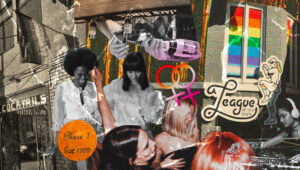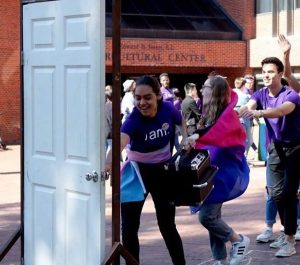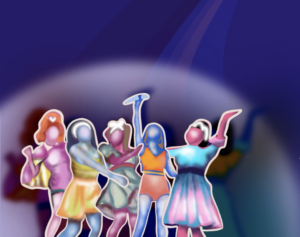With a campus that’s constantly in motion with its students moving at a hundred miles an hour in seemingly endless directions, it can be difficult to gather perspective on the big picture of campus life and even harder to find your place in the madness.
Here are some snapshots of the issues that are at play at Georgetown and the students who have encountered these issues in their undergraduate experience. They have found their piece of the puzzle. Where will you find yours?
- H*yas for Choice table in Red Square. Photo: Georgetown Voice
- Student demonstrates signing at GU Signs meeting
- Healy Hall
- Dahlgren Chapel
- Georgetown Basketball
Socioeconomic Diversity
By James Constant
For a member of the Class of 2018, the full cost of attendance for one academic year at Georgetown is $64,980—roughly the same as a very well-equipped Porsche Cayman sports car. According to U.S. News and World Report, 38.7 percent of undergraduates receive some form of financial aid from Georgetown, yet it is still hard to ignore the fact that the families of most students are spending luxury-car money every year on their child’s education. In fact, Georgetown’s financial model is predicated on 50 percent of the student population paying full tuition every year.
Those sort of numbers paint a pretty clear picture of the economic situation that a substantial proportion of Hoyas were born into, and it’s not exactly surprising—as one of America’s most prestigious universities, Georgetown attracts the sons and daughters of the world’s elite. There are a lot of private-school graduates on the Hilltop—of the 12 high schools that sent the most students to Georgetown last year, 10 were prep schools, many of them storied New England institutions boasting illustrious alumni and exorbitant endowments. The average Georgetown student’s background is not representative of the average American 18-22-year-old’s background. But there’s more to the Georgetown student body than just wealth and privilege.
In the fall of 2005, 50 Georgetown freshmen enrolled as part of a new, experimental initiative to support students from low-income families and first-generation college students. The Georgetown Scholarship Program has since grown into a massive community, providing 640 students—8.6 percent of undergraduates—with a $25,000 scholarship for the 2013-2014 academic year.
According to Missy Foy (COL ‘03), the GSP program director, the initiative has been instrumental in building a dialogue on campus around socioeconomic diversity. “Socioeconomic diversity is as powerful and legitimate a form of diversity as any other,” wrote Foy in an email to the Voice. “People seem to be ‘getting’ that now more than they did a few years ago.”
“Because a lot of student leaders are in GSP, it’s raised the profile of the program, and it gets people asking questions about scholarships and socioeconomic diversity at Georgetown in general,” said Foy. “We’re getting to a good place.”
Despite the efforts of the GSP, only 12 percent of Georgetown undergraduates are first-generation college students—well below the national average of 30 percent. Those first-generation students, however, have shown tremendous promise, with 98 percent graduating, compared to 32 percent nationwide.
Economic issues will remain a problem for many Georgetown students in the foreseeable future. While most students graduate free of debt (61 percent as of 2011, according to the Institute for College Access and Success), who ends up saddled with debt and who doesn’t is almost totally decided by the relative wealth of each student’s parents. The 39 percent of Hoyas that do take on private loans in order to graduate are faced with a substantial obstacle towards future financial stability—an average of $28,035 in loans, $1,435 more than the average American college student.
Jimmy Ramirez (COL ‘15) and Colleen Roberts, (COL ‘15) both chairs of GSP Advocacy and Strategic Outreach, noted that Georgetown’s largely high-income student body often expresses ignorance towards the issues that poorer students face.
“When high-income students inappropriately use the words ‘broke’ or ‘poor’ to describe their financial situation, this demonstrates a lack of understanding,” wrote Ramirez and Roberts in an email to the Voice. “There are Hoyas on this campus who have to work numerous jobs in order to support themselves and families at home. Inappropriately using the words ‘broke’ or ‘poor’ show a small example of how much more needs to be done.”
Catholic Idenity and the LGBTQ Movement
By Elizabeth Baker
As the oldest Catholic university in the country, Georgetown is constantly being pulled between its traditional religious identity and progressive campaigns on campus—the LGBTQ movement for example. Although Georgetown has run into conflict in the past, particularly in the past year when William Peter Blatty (COL ’50) wrote a petition asking that the Vatican strip Georgetown of its distinction as a Catholic university, Georgetown students across campus proudly embrace Georgetown’s pluralistic outlook, which encourages students to use campus as a place for open and thought-provoking dialogue.
In 2007, in response to student activism on the part of the Gay and Lesbian Alliance, President DeGioia announced the opening of the LGBTQ Resource Center, which exists today as a support system and educational resource for students and faculty. Today, the resource center opens its doors to not only LGBTQ members, but also to any student or faculty member looking for guidance. GU Pride is also a large part of campus life, hosting an annual Coming Out week in October and a Lavender Graduation for LGBTQ seniors.
Director of the Center Sivagami Subbaraman describes the relationship between the Center and Campus Ministry as collaborative rather than one of conflict. A queer Catholic prayer group has existed on campus for years. “The struggle [of religious identity] is not different between LGBTQ members or any other student,” Sivagami said. “Even in strict religions, we need to remember that’s not what it’s about. It’s about love.”
GU Pride President Thomas Lloyd (SFS ‘15) also announced that in March 2015, Georgetown will be hosting the Ignatian Q conference, a weekend that invites Jesuit schools’ LGBTQ students to unite in dialogue and growth. “When I was thinking about doing the
conference, [Vice President for Mission and Ministry] Father O’Brien himself said absolutely, of course – just keep us in the loop,” Lloyd said. Celeste Chisholm (COL ‘15), a transgender student, spoke about her relationship with Campus Ministry. “[The relationship between Campus Ministry and LGBTQ on campus is] not nearly as tumultuous as one would expect. There’s a lot of coalescence. I found the Ministry’s reaction [to my coming out] to be very calm and understanding.”
Undoubtedly, Georgetown and its students embrace a rapidly changing modern world, yet Georgetown still remains very true to its traditional Catholic roots. Several student groups, such as the Catholic Daughters and the Knights of Columbus, allow students to live out their Catholic faith among peers. The Grand Knight, Christopher Cannataro (MSB ‘15), describes the Knights of Columbus as “servants to the campus” who readily accept calls to community service and assisting campus ministry.
Despite the personal opinions of each Knight, the group does not rebuff the opinions of other students. Cannataro spoke fervently about the necessity of open-minded discussion around campus to create a safe, accepting environment for all students. “At a university, a hearty dialogue should be able to occur and people should be able to express their views and learn from others. The Knights are ambassadors of our Catholic faith on campus. We should all have mutual respect for differing positions and views, regardless of their popularity. Regardless of differences, we should all be able to work together to build a Hilltop of Love,” he wrote.
Tim Rosenberger (COL ’16), who is openly gay and Republican, believes that the ability to have open and thought-provoking discussions and opinions on campus is what makes Georgetown such a special university. “I think Georgetown is absolutely a safe space. We have all these great intersections, great respect for each other—and I encourage people to bring their voices out, loudly.”
Disability Activism
By Caitriona Pagni
Although Georgetown’s diversity-minded student culture generally emphasizes social justice, one group still exists on the margins. Georgetown students who have mental and physical disabilities face many additional challenges that the typical able-bodied student does not, yet they remain largely invisible to mainstream campus culture. These challenges range from securing academic accommodations from professors to finding campus events that have appropriate accommodations for their disability, even to tasks as simple as traveling across campus.
Lydia Brown (COL ‘15) is an autistic student at Georgetown and an activist for the disabled community. “The idea that disability can be a political identity, that disabled people can have a collective history, that disability itself is a political term in the same way [as] gender or class is not an idea that exists outside of certain communities,” she said.
Brown went on to say that in her work as an activist, she has found that Georgetown is not immune to larger social ideas that propagate ableism: discrimination against disabled persons. “When I interview people at Georgetown who did not want me to use their names, chief among their reasons was the fear that if [they were] found out as disabled they would no longer be treated as a peer because disabled people, particularly mentally disabled people, do not belong here.”
Campus construction projects, such as the Northeast Triangle and the renovations to former Jesuit residences Ryan and Mulledy, will only further complicate life for students with accessibility concerns because many pedestrian walkways will be partially or completely closed.
University officials have acknowledged this concern, and have tried to incorporate solutions into their plans. “We’ve thought carefully about the experiences of our students with disabilities during this time of significant growth and are working to ensure every student has safe and accessible pedestrian pathways throughout campus,” Director of Residential Living Ed Gilhool wrote in an email to the Voice.
Student activists and university officials alike are working hard to make student culture more accepting of students with disabilities. This semester, the University will offer a new class titled Introduction to Disability Studies. Additionally, the Academic Resource Center is working on ways to increase the number of accessible events on campus by streamlining the process for reserving accommodations such as American Sign Language interpreters. “One thing we are encouraging student to do is to put language on their events saying that if a student needs a particular accommodation to notify the appropriate person,” Director of the ARC Jane Holahan said.
In the long term, Brown hopes that the University will establish a disability cultural center, which would function similarly to the LGBTQ resource center, Women’s Center, or the Center for Multicultural Equity and Access. “In mainstream culture there are so few points of resistance to the dominant narratives of disability as something pitiable or something tragic to be overcome. A disability cultural center would create that social nexus for student-led initiatives,” Brown said.
Nia Lazarus (COL ‘16), a founding member of GU Signs, Georgetown’s only ASL club, has seen progress in creating awareness of deaf culture since the club began in 2013 and is optimistic about the future of disability accommodation on campus. “I have seen a lot of people who have never really learned about American Sign language or deaf culture before and it made a difference in their lives. It’s only a matter of time before the whole campus really knows about this.”
Free Speech
By James Constant
Last Martin Luther King Jr. Day, a group of students trudged over to Healy Hall through the chill of the frigid early morning and set up a table. They didn’t have much besides a blue banner with “H*yas for Choice” written on it and a scattered assortment of pamphlets on sexual assault.
Within 18 minutes of their arrival, this innocuous display proved enough to have Georgetown’s Department of Public Safety escort the group from the front gates to continue their activism off campus. These extreme measures left many students on campus confused and outraged. As it turns out, H*yas for Choice had come to protest the Cardinal O’Connor Conference on Life, the largest pro-life conference in the United States, which was to take place inside Healy that day.
This wasn’t the first issue H*yas for Choice had run into with the University. Over the years, the group’s highly publicized conflicts with the University over free speech have shone a spotlight on how Georgetown, as a Catholic university, deals with speech that contradicts the Church’s teachings.
According to Abby Grace (SFS ‘16), president of H*yas for Choice, the organization faced repeated instances of discrimination while tabling in the Leavey Center—H*yas for Choice was allowed to do so only in the case of inclement weather. “We had a lot of issues with ‘what is freezing?’, because if the windchill was really bad but it was 40 degrees, we had to leave the Leavey Center and go back to Red Square,” Grace said.
Last May, the University revised its Speech and Expression policy after a long, drawn-out process that involved forums, surveys, committees, and a “memorandum of understanding” that was eventually agreed upon by former Georgetown University Student Association President Nate Tisa and Vice President for Student Affairs Todd Olson.
Today, there are four official “free speech zones” where students are allowed to freely express their views: the Healey Family Student Center lobby, the lobby of the Leavey Center, Red Square, and the lawn outside of Regents Hall. The new policy also provides protection for student protests anywhere on campus as long as no other university policies are violated.
The new free speech code provides clarifications for campus media outlets like the Voice, The Hoya, and WGTB. Previously, student DJs for WGTB were discouraged from talking about contraception on-air—now the only restriction levied is that campus media may not publish advertisements for contraception or abortion.
Despite the changes, the Foundation for Individual Rights in Education wrote in May that “the establishment of four official free speech zones is still inconsistent with Georgetown’s stated commitments to free speech. Rather than being confined to specific zones, students should be permitted to engage in expressive activities in any traditionally public areas of campus.” FIRE has previously rated Georgetown as a “red light institution”—meaning it has “at least one policy that both clearly and substantially restricts freedom of speech.”
Current GUSA President Trevor Tezel (SFS ’15) stressed the importance of students exercising their right to individual expression in an interview with the Voice. “Do what seems right and what would be natural in a college environment, and let us take on advocating on your behalf,” said Tezel.
“If one thing is clear to the University administration, it’s that if a student group is forcibly removed from an area, that won’t be the end of the story… there will be pushback, there will be press, and it’s up to us to push the boundaries of what’s seen as acceptable.”
Additional reporting from Ambika Ahuja, Dayana Morales Gomez, and Ryan Greene
Photos: The Georgetown Voice







